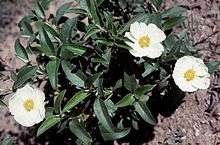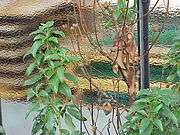Cistus laurifolius
Cistus laurifolius, commonly called laurel-leaf cistus,[1] laurel-leaved cistus[2] or laurel-leaved rock rose, is a species of highly branched flowering evergreen shrub native to some areas around the Mediterranean.
| Cistus laurifolius | |
|---|---|
 | |
| Scientific classification | |
| Kingdom: | Plantae |
| Clade: | Tracheophytes |
| Clade: | Angiosperms |
| Clade: | Eudicots |
| Clade: | Rosids |
| Order: | Malvales |
| Family: | Cistaceae |
| Genus: | Cistus |
| Species: | C. laurifolius |
| Binomial name | |
| Cistus laurifolius | |
Description
It grows 0.8–2 m (2 ft 7 in–6 ft 7 in) high. The branches are strong and erect, with reddish bark that is easily removed in strips. The leaves are larger than in the other species of Cistus, up to 9 cm (4 in) long, lanceolate, dark green, while the underside is whitish due to trichomes. The flowering occurs in late spring (May–June), later than most rockroses.[3] It bears white flowers with a yellow spot in each petal, of 4.5–5 cm diameter[4] It is widely cultivated in gardens, and has gained the Royal Horticultural Society's Award of Garden Merit.[5]
Distribution and habitat
Cistus laurifolius has a disjunct natural distribution, in the Western Mediterranean area (Morocco, Portugal, Spain, southern France, Corsica and Tuscany), the Aegean and Anatolia.[4]
With the general warming of the atmosphere and the consequent withdrawal of the ice, flora surviving from Tertiary times could not re-establish their range in southern Europe; the new post-glacial climate was drier than that of the Tertiary. The original tropical European flora evolved into the present Mediterranean sclerophyll flora.[6][7][8] The distribution of some surviving species, such as Cistus laurifolius, moved to wetter areas such as the mountains.[8] Due to this, C. laurifolius is named in Spanish in its distribution area as "mountain rockrose",[8] although in the coastal west and northwest Iberian Peninsula, it is found at sea level.[9]
Cistus shrubland, including C. laurifolius, survives fire and has seeds that germinate after fire.[10]
Phylogeny
Cistus laurifolius belongs to the white and whitish pink flowered clade of Cistus species.
| Species-level cladogram of Cistus species. | ||||||||||||||||||||||||||||||||||||||||||||||||||||||||||||||||||||||||||||||||||||||||||||||||||||||||||||||
| ||||||||||||||||||||||||||||||||||||||||||||||||||||||||||||||||||||||||||||||||||||||||||||||||||||||||||||||
| Species-level cladogram of Cistus species, based on plastid and nuclear DNA sequences.[11][12][13][14] |
Gallery
- Laurel-leaf cistus in its ecosystem.
- General view of the shrub.
 Young branches with the large leaves.
Young branches with the large leaves.- The fruits are capsules, with dehiscence revealing seeds within.
Subtaxa
- Cistus laurifolius var. atlanticus Pit.[15]
- Cistus laurifolius var. lanceolatus Rouy & Foucaud
- Cistus laurifolius var. laurifolius
- Cistus laurifolius var. ovatus Rouy & Foucaud
References
- "Cistus laurifolius". Germplasm Resources Information Network (GRIN). Agricultural Research Service (ARS), United States Department of Agriculture (USDA). Retrieved 16 January 2018.
- "BSBI List 2007". Botanical Society of Britain and Ireland. Archived from the original (xls) on 2015-01-25. Retrieved 2014-10-17.
- Filippi, Olivier (2007). Pour un jardin sans arrosage (For a garden without irrigation). Arles: Actes Sud. p. 207. ISBN 978-2-7427-6730-4.
- Flora Iberica 3: 331
- http://apps.rhs.org.uk/plantselector/plant?plantid=430
- John W. Harshberger (1926). "Mediterranean Garigue and Macchia (first page)". Proceedings of the American Philosophical Society. 65 (1): 56–63. JSTOR 984338.
- Fernández-Mazuecos, M.; Vargas, P. (2010). "Ecological rather than geographical isolation dominates Quaternary formation of Mediterranean Cistus species". Molecular Ecology. 19 (7): 1381–1395. doi:10.1111/j.1365-294x.2010.04549.x. PMID 20196815.
- Beatriz Guzmán; Pablo Vargas (2005). "Systematics, character evolution, and biogeography of Cistus L. (Cistaceae) based on ITS, trnL-trnF, and matK sequences" (PDF). Molecular Phylogenetics and Evolution. 37 (3): 644–660. doi:10.1016/j.ympev.2005.04.026. PMID 16055353.
- Antonio Rigueiro Rodríguez; Fco. Javier Silva-Pando. "Aportaciones A La Flora De Galicia, I." (PDF). Anales Jard. Bot. Madrid. 40 (2): 385–395.
- R. Tárrega; E. Luis-Calabuig; I. Alonso (1997). "Space-time heterogeneity in the recovery after experimental burning and cutting in a Cistus laurifolius shrubland". Plant Ecology. 129 (2): 179–187. doi:10.1023/A:1009728317705. Archived from the original on 2012-07-09. Retrieved 2012-05-10.
- Guzmán, B. & Vargas, P. (2005). "Systematics, character evolution, and biogeography of Cistus L. (Cistaceae) based on ITS, trnL-trnF, and matK sequences". Molecular Phylogenetics and Evolution. 37 (3): 644–660. doi:10.1016/j.ympev.2005.04.026. PMID 16055353.
- Guzmán, B. & Vargas, P. (2009). "Historical biogeography and character evolution of Cistaceae (Malvales) based on analysis of plastid rbcL and trnL-trnF sequences". Organisms Diversity & Evolution. 9 (2): 83–99. doi:10.1016/j.ode.2009.01.001.
- Guzman, B.; Lledo, M.D. & Vargas, P. (2009). "Adaptive Radiation in Mediterranean Cistus (Cistaceae)". PLOS ONE. 4 (7): e6362. Bibcode:2009PLoSO...4.6362G. doi:10.1371/journal.pone.0006362. PMC 2719431. PMID 19668338.
- Civeyrel, Laure; Leclercq, Julie; Demoly, Jean-Pierre; Agnan, Yannick; Quèbre, Nicolas; Pélissier, Céline & Otto, Thierry (2011). "Molecular systematics, character evolution, and pollen morphology of Cistus and Halimium (Cistaceae)". Plant Systematics and Evolution. 295 (1–4): 23–54. doi:10.1007/s00606-011-0458-7.CS1 maint: ref=harv (link)
- "Tropicos.org".
| Wikimedia Commons has media related to Cistus laurifolius. |
| Wikispecies has information related to Cistus laurifolius |